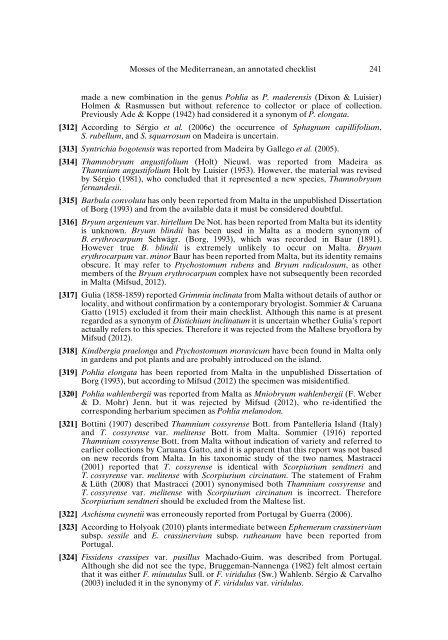Mosses of the Mediterranean, an annotated checklist - Optima-bot.org
Mosses of the Mediterranean, an annotated checklist - Optima-bot.org
Mosses of the Mediterranean, an annotated checklist - Optima-bot.org
Create successful ePaper yourself
Turn your PDF publications into a flip-book with our unique Google optimized e-Paper software.
<strong>Mosses</strong> <strong>of</strong> <strong>the</strong> <strong>Mediterr<strong>an</strong>e<strong>an</strong></strong>, <strong>an</strong> <strong>an</strong>notated <strong>checklist</strong> 241made a new combination in <strong>the</strong> genus Pohlia as P. maderensis (Dixon & Luisier)Holmen & Rasmussen but without reference to collector or place <strong>of</strong> collection.Previously Ade & Koppe (1942) had considered it a synonym <strong>of</strong> P. elongata.[312] According to Sérgio et al. (2006c) <strong>the</strong> occurrence <strong>of</strong> Sphagnum capillifolium,S. rubellum, <strong>an</strong>d S. squarrosum on Madeira is uncertain.[313] Syntrichia bogotensis was reported from Madeira by Gallego et al. (2005).[314] Thamnobryum <strong>an</strong>gustifolium (Holt) Nieuwl. was reported from Madeira asThamnium <strong>an</strong>gustifolium Holt by Luisier (1953). However, <strong>the</strong> material was revisedby Sérgio (1981), who concluded that it represented a new species, Thamnobryumfern<strong>an</strong>desii.[315] Barbula convoluta has only been reported from Malta in <strong>the</strong> unpublished Dissertation<strong>of</strong> B<strong>org</strong> (1993) <strong>an</strong>d from <strong>the</strong> available data it must be considered doubtful.[316] Bryum argenteum var. hirtellum De Not. has been reported from Malta but its identityis unknown. Bryum blindii has been used in Malta as a modern synonym <strong>of</strong>B. erythrocarpum Schwägr. (B<strong>org</strong>, 1993), which was recorded in Baur (1891).However true B. blindii is extremely unlikely to occur on Malta. Bryumerythrocarpum var. minor Baur has been reported from Malta, but its identity remainsobscure. It may refer to Ptychostomum rubens <strong>an</strong>d Bryum radiculosum, as o<strong>the</strong>rmembers <strong>of</strong> <strong>the</strong> Bryum erythrocarpum complex have not subsequently been recordedin Malta (Mifsud, 2012).[317] Gulia (1858-1859) reported Grimmia inclinata from Malta without details <strong>of</strong> author orlocality, <strong>an</strong>d without confirmation by a contemporary bryologist. Sommier & Caru<strong>an</strong>aGatto (1915) excluded it from <strong>the</strong>ir main <strong>checklist</strong>. Although this name is at presentregarded as a synonym <strong>of</strong> Distichium inclinatum it is uncertain whe<strong>the</strong>r Gulia’s reportactually refers to this species. Therefore it was rejected from <strong>the</strong> Maltese bry<strong>of</strong>lora byMifsud (2012).[318] Kindbergia praelonga <strong>an</strong>d Ptychostomum moravicum have been found in Malta onlyin gardens <strong>an</strong>d pot pl<strong>an</strong>ts <strong>an</strong>d are probably introduced on <strong>the</strong> isl<strong>an</strong>d.[319] Pohlia elongata has been reported from Malta in <strong>the</strong> unpublished Dissertation <strong>of</strong>B<strong>org</strong> (1993), but according to Mifsud (2012) <strong>the</strong> specimen was misidentified.[320] Pohlia wahlenbergii was reported from Malta as Mniobryum wahlenbergii (F. Weber& D. Mohr) Jenn. but it was rejected by Mifsud (2012), who re-identified <strong>the</strong>corresponding herbarium specimen as Pohlia mel<strong>an</strong>odon.[321] Bottini (1907) described Thamnium cossyrense Bott. from P<strong>an</strong>telleria Isl<strong>an</strong>d (Italy)<strong>an</strong>d T. cossyrense var. melitense Bott. from Malta. Sommier (1916) reportedThamnium cossyrense Bott. from Malta without indication <strong>of</strong> variety <strong>an</strong>d referred toearlier collections by Caru<strong>an</strong>a Gatto, <strong>an</strong>d it is apparent that this report was not basedon new records from Malta. In his taxonomic study <strong>of</strong> <strong>the</strong> two names, Mastracci(2001) reported that T. cossyrense is identical with Scorpiurium sendtneri <strong>an</strong>dT. cossyrense var. melitense with Scorpiurium circinatum. The statement <strong>of</strong> Frahm& Lüth (2008) that Mastracci (2001) synonymised <strong>bot</strong>h Thamnium cossyrense <strong>an</strong>dT. cossyrense var. melitense with Scorpiurium circinatum is incorrect. ThereforeScorpiurium sendtneri should be excluded from <strong>the</strong> Maltese list.[322] Aschisma cuynetii was erroneously reported from Portugal by Guerra (2006).[323] According to Holyoak (2010) pl<strong>an</strong>ts intermediate between Ephemerum crassinerviumsubsp. sessile <strong>an</strong>d E. crassinervium subsp. ru<strong>the</strong><strong>an</strong>um have been reported fromPortugal.[324] Fissidens crassipes var. pusillus Machado-Guim. was described from Portugal.Although she did not see <strong>the</strong> type, Bruggem<strong>an</strong>-N<strong>an</strong>nenga (1982) felt almost certainthat it was ei<strong>the</strong>r F. minutulus Sull. or F. viridulus (Sw.) Wahlenb. Sérgio & Carvalho(2003) included it in <strong>the</strong> synonymy <strong>of</strong> F. viridulus var. viridulus.






